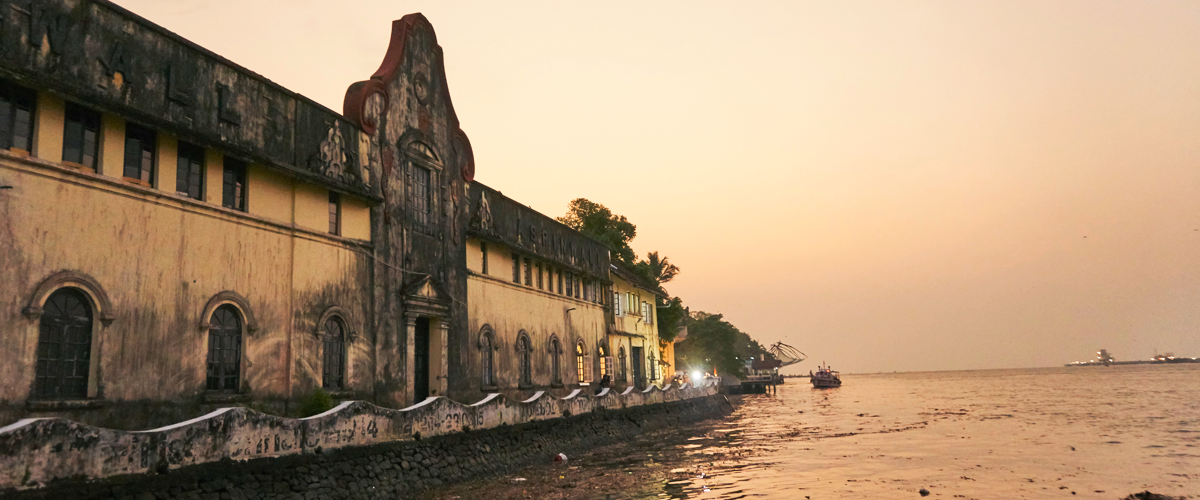I wondered if 1.30 in the afternoon was an odd hour to call and set up a meeting. But I’m glad I made the call. He answered on the third ring and agreed to meet at 5. Three minutes before 5, he called to let me know he was at the cafe in Aspinwall House, the main venue for Kochi-Muziris Biennale 2016-17. And that was my first meeting with internationally acclaimed artist and curator, Bose Krishnamachari, who has firmly established Kochi as a centre for art and expression.
I was in Kochi for the Biennale, a 108-day art and culture festival. It was started, curated and continues to be run by artists. This edition features 97 artists from 31 countries exhibiting over 114 works of art across 12 venues. And with Teabox as the official tea partner.
We chose a cup of the Mountain Rose (to which Bose is already a convert) and spoke about Kochi, art, and tea. Born in Kerala, Bose moved to Mumbai to study at the Sir J.J. School of Art. After a Master’s in London, he chose to return to India and set up base in Mumbai. “But Kerala,” he says, “will always be home.”

Which would explain why he is such an integral part of the Biennale. Sometime in 2010, M. A. Baby (then state minister for Culture) came to Mumbai and met Bose along with a few other artists over dinner. The minister asked them what could be done to improve Kerala’s visual art scene. The state had a theatre festival in Thrissur, a film festival in Trivandrum but despite churning out some of India’s best artists, there was little to establish Kerala as a center for visual arts. The answer was the first edition of the Kochi-Muziris Biennale put together by Bose and Riyas Komu in 2012.
The story of the festival goes back some more. Muziris on the Malabar coast was one of the oldest ports, in operation till 1341 and was a point of trade with over 50 countries. The consequence was that it became a melting pot of multiple religions and culture with 33 communities speaking 16 languages. It seemed like the ideal choice and with Kochi, became host to the festival.
Even as Bose made his return home to put together a festival of such magnitude, it seems that he’s roped in the whole city. Pepper House is a heritage property between Fort Kochi and the Bazaar Road. Once a warehouse, this 16,000 square feet of space includes two large buildings. Pepper House has been part of the Biennale from its first year and has since been transforming into a visual arts space, also the venue for the artist residency. The royal Durbar Hall, a venue for the 1st Biennale was renovated and returned to the state by the festival organisers. More such venues have been embraced by the return of the festival every other year.
“What the Biennale has done is create an ecosystem for art, culture. I think the city is becoming an art route. It used to be a trade route. We cannot teach art. It can only be imbibed. It’s an opportunity for receiving things. If you’re open to it, there are many many things you can take back. Here is an ideal model of religion, tolerance and harmony. In the midst of a politically pressured space, we’re a harmonious community.” says Bose.
The 3rd edition of the Biennale is larger in scale. It has been curated by Sudarshan Shetty, a painter who’s as famous or more for his assemblages, installations, video and performances. The theme for the year is ‘forming in the pupil of an eye’ – a line lifted from a poem by Shetty’s friend. The idea is to showcase the Biennale as ‘existing in process’, designed to convey the notion of incompleteness. And he has done so by engaging artists to create works of art that exist not only for the duration of the Biennale but even beyond.
A visit to the Biennale is to immerse yourself in an intersection of history, contemporary art and artists. Here, time seems to run its own course, abstract from the mainland by a sea of expression. Whether it’s a city that’s embraced the art it exhibits, or art that’s a reflection of the city’s multiplicities, the Biennale is an experience that anyone can appreciate. Art enthusiast or not.
Featured banner of Aspinwall House. Photographs by the author.


1 Comment
Fascinating. A real story of which came first, the chicken or the egg.